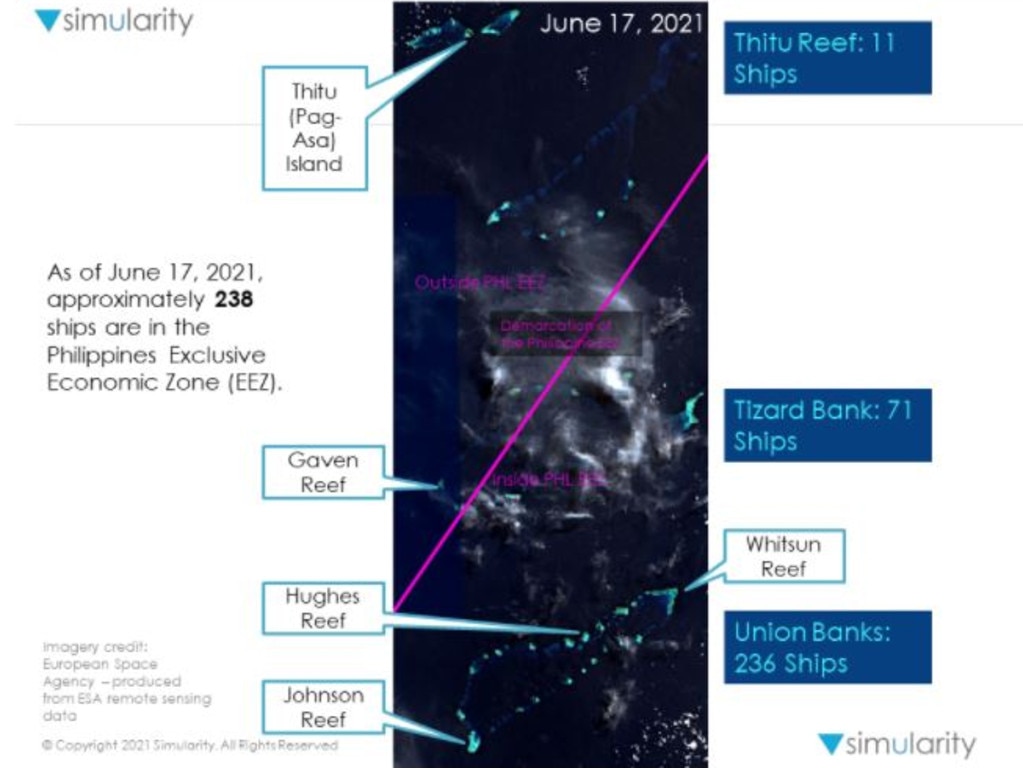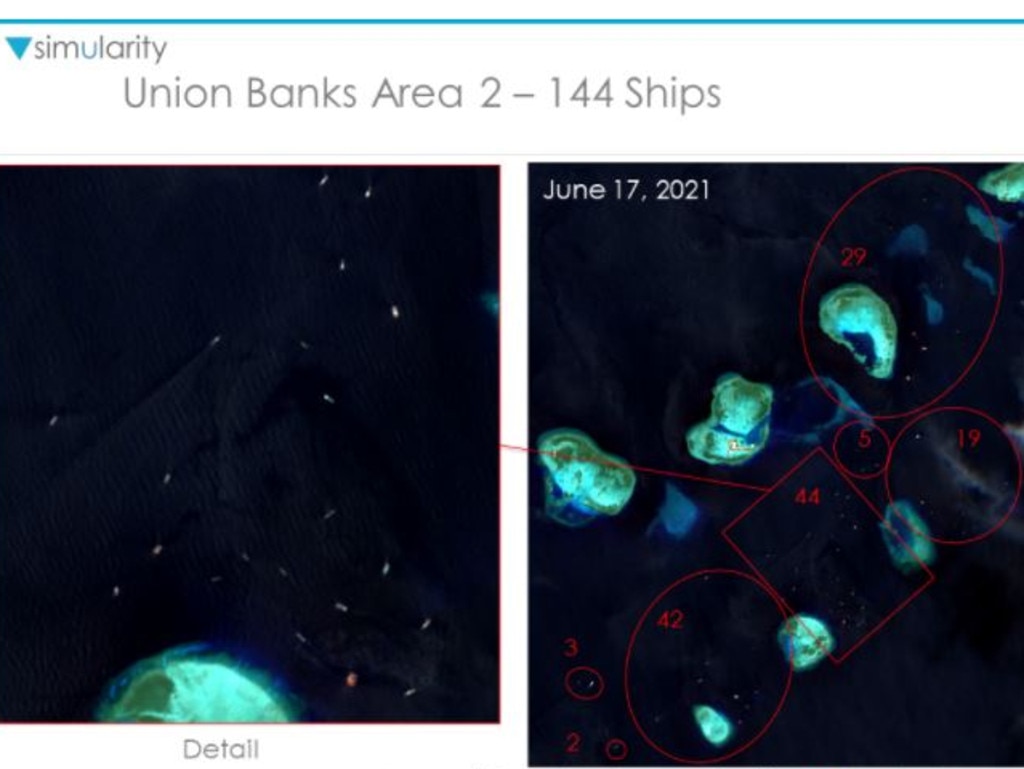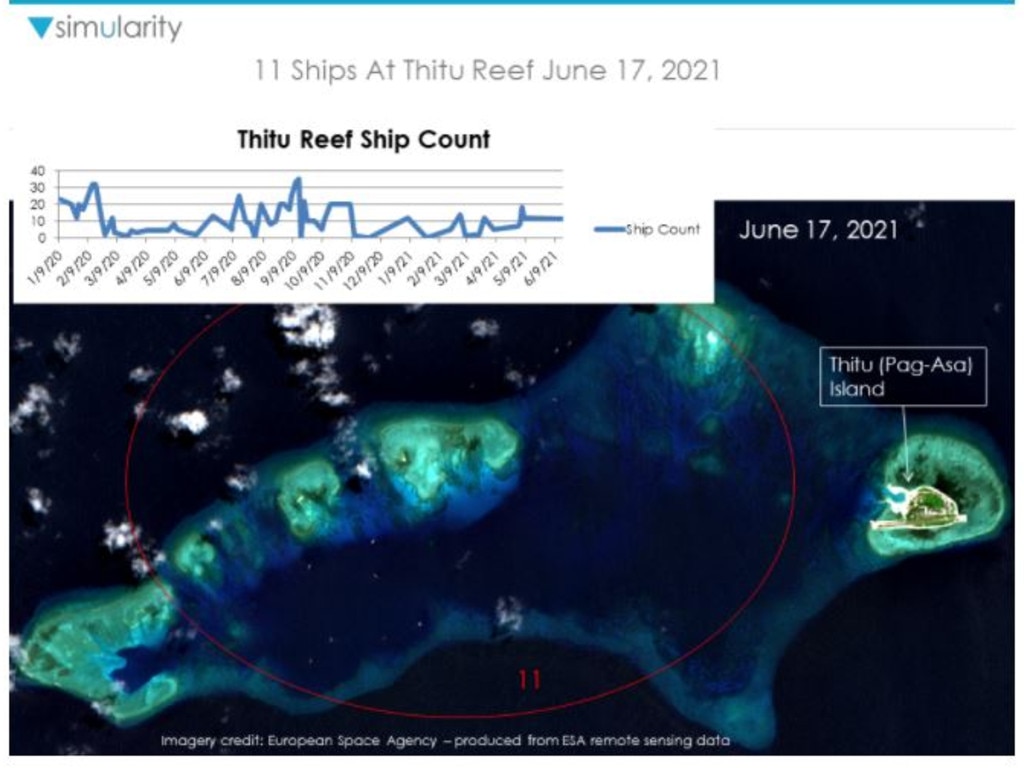Philippines sees mysterious ships push into local waters
Alarming photos show that instead of standing down, China has doubled down and is “shamelessly hellbent on aggravating the situation”.
They shouldn’t be fishing boats. China has imposed a blanket ban. But 100 more vessels have moved into the Philippines’ Union Banks, bringing the total to 238.
Is this another sign of Beijing using “all means short of war” to seize control?
Geospatial analysis firm Simularity has released a report dissecting hundreds of satellite images taken of the Spratly Islands in the South China Sea in recent weeks.
“As of June 17, 2021, approximately 238 ships are in the Philippines’ Exclusive Economic Zone (EEZ),” the report concludes.
That’s at least 100 more than what was there a month ago.
The unidentified vessels were photographed clustered around Union Banks in the centre of the contested Spratly Islands group.
RELATED: America’s new ‘force’ in South China Sea


In March, about 220 Chinese fishing vessels – including many identified as belonging to the Communist Party’s trained militia – gathered at the nearby Julian Felipe Reef, also part of the Union Banks. Despite blue skies and fair winds, Beijing insisted the boats were sheltering from a storm.
“We had protested, pleaded and stood up for months, but [China] just ignored it all. Instead of leaving our territories and obeying the law, they seem to have added a huge [number of ships],” Philippines Senator Risa Hontiveros said on Wednesday.
‘Hellbent aggravation’
Members of the Manila government say Beijing’s duplicity has angered them.
“Instead of de-escalating the tensions in the disputed waters, they doubled down,” accused Senator Hontiveros.
“This clearly shows that China is shamelessly hellbent on aggravating the situation.”
RELATED: Beijing’s disturbing new military move

The Philippines, which does not recognise Beijing’s jurisdiction over the islands, continues to allow its fishers to remain active in the South China Sea.
Manila won a 2015 international court of arbitration case brought against Beijing. It found China’s “Nine Dash Line” claim to the entirety of the South China Sea to be without historical basis or foundation under the United Nations Convention on the Law of the Sea (UNCLOS).
China has rejected the ruling.
“China is more confident about working with the Southeast Asian nations to jointly shape the South China Sea order in line with the long-term interests of the region,” state-controlled Chinese media reports.
“To this effect, China and the Philippines have established a bilateral consultation mechanism for the South China Sea issue, which has helped them reach many consensuses.”
‘Dignity and Respect’
Patience within the Manila government towards President Duterte’s attempts to appease Beijing appears to be running out.
“Now that China has added more ships, maybe the Palace will rise up. But, if not, we Filipinos must learn not to choose a leader that will not stand up for us,” Hontiveros said.
“The DFA needs to summon the Chinese Ambassador again for intensive talks. China’s relentless aggression against our country cannot continue. We, as a nation, are owed dignity and respect.”
Beijing insists Manila has been misled.
“The South China Sea arbitration award has had a negative impact on the situation and related disputes in the South China Sea,” a China Daily editorial asserts.
“In the past year, under the banner of ‘maintaining and respecting international law,’ some countries, regional and extra-regional, have invoked the South China Sea arbitration award to try and legitimise their actions aimed at denying China’s claims in the South China Sea. The illegal and invalid South China Sea arbitration award in 2016 has, in turn, contributed to the intensification of the South China Sea outer continental shelf issue.”
Target: Pag-asa
China’s “fishing” militia is keeping up the political pressure. Even if it can’t fish.
The Simularity analysis identified 11 unidentified vessels clustered tightly around the Philippines’ Pag-asa (Thitu) Island.
RELATED: China’s spy’s embarrassing intelligence

This Philippine-occupied island has an airstrip, medical centre and a small village.
Unlike nearby Chinese artificial island fortresses, it does not have missile and gun towers, hardened hangars, ammunition dumps and extensive barracks facilities.
Instead, it has a town hall and a small joint coast guard and fishing ramp.
Pag-asa’s fishers regularly complain of Chinese “harassment” and of being forced away from nearby sandbanks. Manila has done little to respond with its limited naval presence.
An average of 18 Chinese militia vessels was recorded around the island between December and March as the Philippines government attempted to upgrade the runway. Up to 88 blockaded Pag-asa in December 2019.
“Most are trawlers, and yet they sit stationary, clearly not trawling. A small number are falling net vessels, but they have no gear deployed,” The Asia Maritime Transparency Initiative (AMTI) of the Center for Strategic and International Studies stated at the time.
But that has begun to change.
Hardening Resolve
“The Palace should look Beijing straight in the eye and tell her to remove her ships from our territories,” Senator Hontiveros said this week.
AMTI says that from March 1 to May 25, it had observed “13 Philippine law enforcement or military vessels paying a total of 57 visits to waters around the Spratly Islands and Scarborough Shoal”.
This was “a substantial increase over the previous ten months when three vessels were tracked making seven total visits to contested features”.
Beijing blames the United States for the increase in regional tensions.
“The “militarisation” of the South China Sea, which is led by the United States and followed by some other extra-regional countries, has intensified,” the China Daily accuses.
“Both the scale and frequency of military activities in the South China Sea conducted by these countries have increased.
“If the coastal states of the South China Sea work together to promote maritime co-operation and try to eliminate external interferences, long-term stability in the South China Sea can be secured.”
Jamie Seidel is a freelance writer | @JamieSeidel




